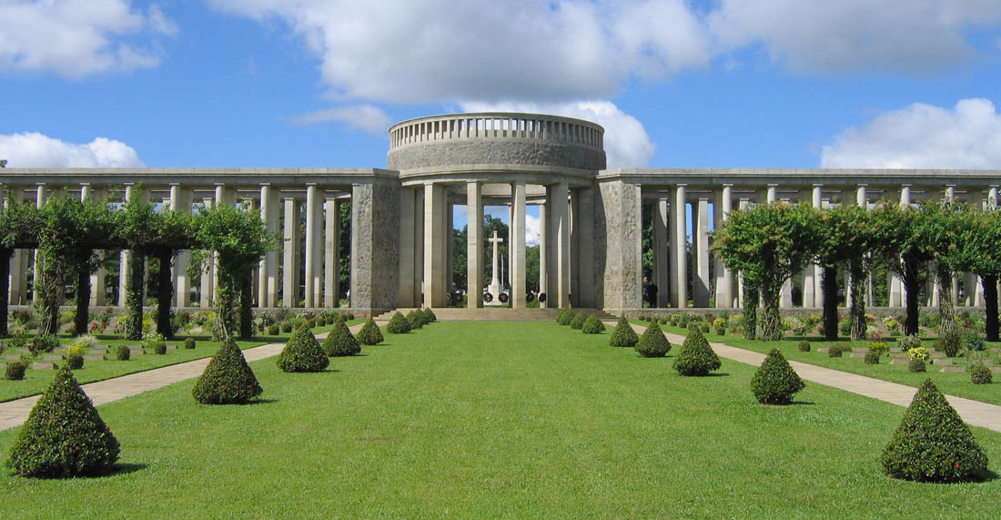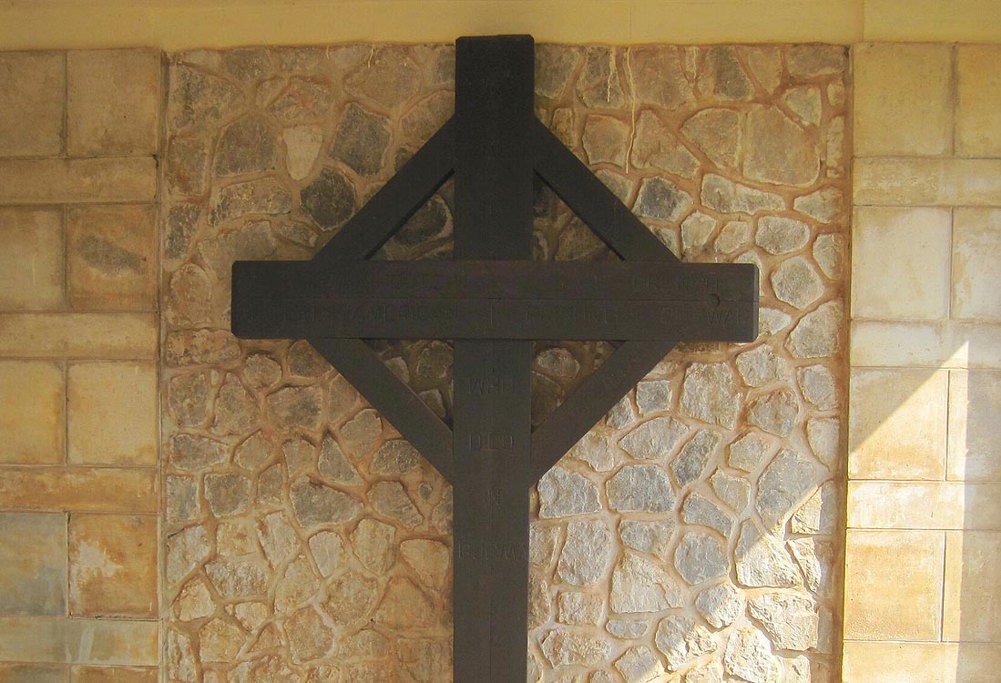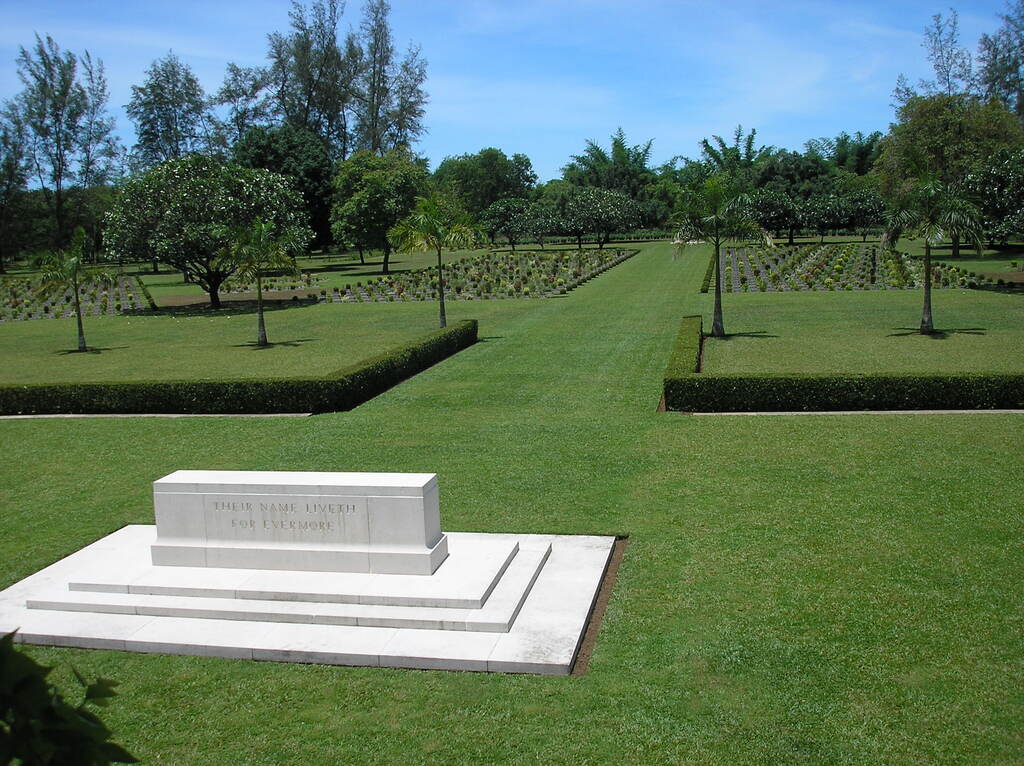Thanbyuzayat War Cemetery
- Country Myanmar
- Total identified casualties 3626 Find these casualties
- Identified casualties from Second World War
- GPS Coordinates Latitude: 15.97341, Longitude: 97.71884
gardens of the death railway

Thanbyuzayat WAR CEMETERY
Location: Thanbyuzayat, Myanmar Language: Burmese Altitude: 23m Rainfall: 2,378mm
Temperature: 19°c - 41°c Biggest challenge: Extreme weather
Pounding heat and flash floods – the weather in Myanmar poses the Commonwealth War Graves Commission its fair share of difficulties.
Our team here is responsible for maintaining nearly 12,000 graves, but the graves look a little different to those familiar with our work in Europe. Each one is marked by a bronze plaque set into the ground on a pedestal of stone.

In Myanmar bronze plaques take the place of Portland headstones to better withstand the climate.
These plaques weather better than Portland headstones in the intense heat and the rain of South East Asia.
In Yangon – known to the British during the Second World War as Rangoon – we face opposing problems from the weather.
Rangoon War Cemetery, in the busy city centre, gets regularly submerged by flash floods. Our gardeners have to sweep away debris on a daily basis in the rainy season.

The iconic Rangoon Memorial at the heart of Taukkyan War Cemetery.
Yet just one hour away on the outskirts, at Taukkyan War Cemetery, we face a constant battle against the parched ground in the brutally hot and dry weather.
Taukkyan is a vast cemetery with almost 6,500 graves. They are carefully laid out in rows around the distinctive shape of the Rangoon Memorial, which lists almost 27,000 missing war dead.
The war memorial is beginning to show signs of its age and we are preparing to restore it.
In its shadow, lies a more recent row of bronze plaques. They sit in a special plot, naming the 16 men aboard Dakota KN584.
The plane crashed in September 1945 killing all aboard. Only recently was it found they had been buried deep in the jungle, making recovery impractical. Instead, their relatives now have somewhere accessible to pay their respects with a row of special memorials in our war cemetery.
The last of our three sites in Myanmar is Thanbyuzayat. The cemetery sits a stone’s throw from the end of the infamous death railway.

A cross at the entrance to Thanbyuzayat, made from wooden sleepers on the death railway.
This cross-country route was built by forced labour, including prisoners of war, during the Second World War, in often gruelling conditions. It has been said that a man died for every sleeper laid across the 415-kilometre (258 mi) route of the railway. Many of those who died, lie at rest in CWGC’s care.
And as a reminder of what they went through, visitors to Thanbyuzayat will see a handmade wooden cross in the cemetery’s entrance, assembled out of those infamous railway sleepers by prisoners.

Our dedicated team in Myanmar.
Location information
The village of Thanbyuzayat is 65 kilometres south of the port of Moulmein, and the war cemetery lies at the foot of the hills which separate the Union of Myanmar from Thailand. Travel from Yangon to Moulmein is possible by both rail and road. It will take between 6-7 hours by road and 12 hours by rail.
Visiting information
The cemetery is open everyday between 07:00-17:00.
History information
The notorious Burma-Siam railway, built by Commonwealth, Dutch and American prisoners of war, was a Japanese project driven by the need for improved communications to support the large Japanese army in Burma. During its construction, approximately 13,000 prisoners of war died and were buried along the railway. An estimated 80,000 to 100,000 civilians also died in the course of the project, chiefly forced labour brought from Malaya and the Dutch East Indies, or conscripted in Siam (Thailand) and Burma (Myanmar).
Two labour forces, one based in Siam and the other in Burma worked from opposite ends of the line towards the centre. The Japanese aimed at completing the railway in 14 months and work began in June 1942. The two sections of the line finally met near Konkoita towards the end of October 1943 and the completed line, 424 kilometres long, was operational by December 1943.
The graves of those who died during the construction and maintenance of the Burma-Siam railway (except for the Americans, whose remains were repatriated) were transferred from camp burial grounds and isolated sites along the railway into three cemeteries at Chungkai and Kanchanaburi in Thailand and Thanbyuzayat in Myanmar.
Thanbyuzayat became a prisoner of war administration headquarters and base camp in September 1942 and in January 1943 a base hospital was organised for the sick. The camp was close to a railway marshalling yard and workshops, and heavy casualties were sustained among the prisoners during Allied bombing raids in March and June 1943. The camp was then evacuated and the prisoners, including the sick, were marched to camps further along the line where camp hospitals were set up. For some time, however, Thanbyuzayat continued to be used as a reception centre for the groups of prisoners arriving at frequent intervals to reinforce the parties working on the line up to the Burma-Siam border.
Thanbyuzayat War Cemetery was created by the Army Graves Service who transferred to it all graves along the northern section of the railway, between Moulmein and Nieke.
There are now 3,149 Commonwealth and 621 Dutch burials of the Second World war in the cemetery.



